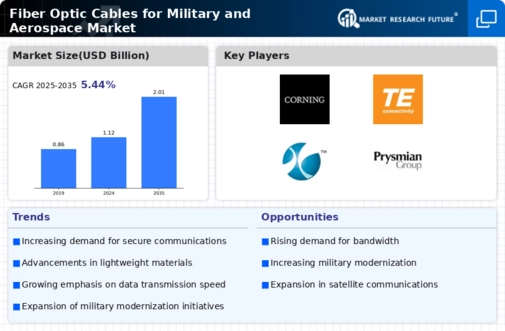Fiber Optic Cable For Military Aerospace Market Summary
The Global Fiber Optic Cables for Military and Aerospace Market is projected to grow from 1.12 USD Billion in 2024 to 2.01 USD Billion by 2035.
Key Market Trends & Highlights
Fiber Optic Cables for Military and Aerospace Key Trends and Highlights
- The market is expected to witness a compound annual growth rate of 5.44 percent from 2025 to 2035.
- By 2035, the market valuation is anticipated to reach 2.01 USD Billion, indicating robust growth potential.
- In 2024, the market is valued at 1.12 USD Billion, reflecting a strong foundation for future expansion.
- Growing adoption of advanced communication technologies due to increasing defense modernization efforts is a major market driver.
Market Size & Forecast
| 2024 Market Size | 1.12 (USD Billion) |
| 2035 Market Size | 2.01 (USD Billion) |
| CAGR (2025-2035) | 5.44% |
Major Players
Amphenol Corporation (US), Raytheon Technologies Corporation (US), Carlisle Interconnect Technologies (US), Corning Incorporated (US), Finisar Corporation (US), L. Gore & Associates, Inc. (US), OFS Fitel, LLC (US), AFL (US), TE Connectivity (Switzerland), Radiall (France), Prysmian Group (Italy), Optical Cable Corporation (US), Timbercon, Inc. (US)















Leave a Comment